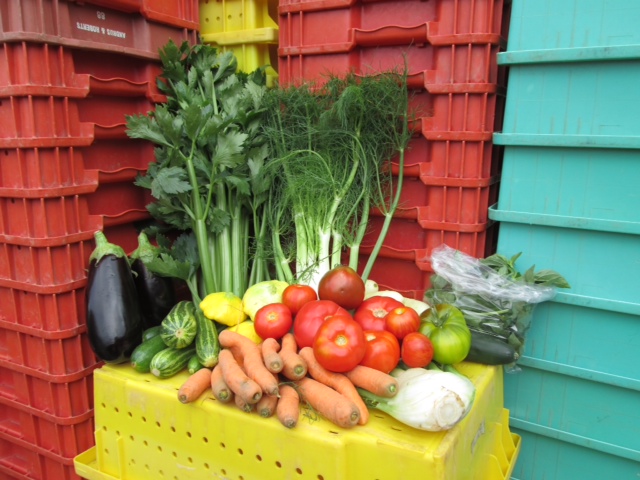You’ll notice this week that the contents of the share changed from the projection sent out just this morning…the bounty of eggplant and several other items instigated some last-minute creative shuffling but we think the end result was quite nice!
This week there are lots of comments in the crop notes about storage temperatures and preferences of each crop. We realize that its not easy to store everything at the ideal temperature, especially all in the same refrigerator- which is why we have three separate refrigerators on the farm that we operate at different temperatures and relative humidity to ensure that our crops are stored under the optimum conditions so they can arrive in your share at their very best. Basil, tomatoes, and eggplant all struggle with the cold temps of a home refrigerator and oftentimes cold damage is the top reason these items don’t last at home. Basil turns black, tomatoes turn mealy and bland, and eggplant gets pockmarks and sunken spots due to excessive cold.
We are working on some rather large harvest projects on the farm- we have a field of carrots that are ready for harvest as well as a large amount of our storage onions to haul into the greenhouses for curing (more on that process later). The pepper plants are looking lush and full of fruit, the corn fields are tasseling, the winter squash is looking beautiful, and as always this time of year, the weeds are thriving as well. We also have winter crops and hearty winter greens coming along in the greenhouse that will provide us with food late in the season and into winter.
In Your Share This Week:
- Basil
- Carrots
- Celery
- Cucumbers
- Eggplant (either Japanese or Italian)
- Fennel
- Summer Squash Mix
- Tomatoes
Crop Notes
Basil: This is the first harvest for us this season. We are picking the end tips of the plants so they’re nice and tender. The ideal storage temperature for basil is no less than 55…so as you can imagine, inside your refrigerator is far too cold and over the course of several days to a week it will turn the basil black and slimy. It can likely withstand a night or two in the veggie drawer, but be sure to keep it away from the coldest parts of your refrigerator.
Celery: Prepare yourself for a whole new experience of celery! We are all familiar with the crisp, watery quality of celery from the grocery store…but this is old-fashioned celery flavor that most people likely have not gotten to taste. We left the entire plant intact so you can turn all of the beautiful foliage into delicious bases for soups and stocks- definitely not to be missed out on.
Fennel: The variety in your share this week tends to have a fairly spreading growth habit, sometimes with stems that shoot out nearly sideways. We realize this may be a bit unwieldy to wrangle into a bag or into the refrigerator…but the fronds are so good we left them on anyhow. When you get your share home you can trim the fronds off of the main bulb and store them all together in a plastic bag. The fronds are good for up to two weeks, but we have seen fennel bulbs last for a month in storage trials.
Tomatoes: We grow several varieties of red slicing tomatoes, over a dozen heirloom varieties, and are also hosting a blind trial of slicers with OSU where we are evaluating the yield, health of the plants, taste, storage, and length of harvest- but we don’t know what each variety is, we only see ‘test #1’, ‘test#2’, etc. Its fun to work with new varieties and watch just how different each one can be. Our heirloom tomatoes are also yielding with gathering speed, so we will start adding those to the shares on rotation- if you do not see them in your share this week, you will get them next week. We have a whole rainbow of colors, shapes, sizes, and flavors that we hope you enjoy. They are a treat to look at on the plate as well with pink, orange, green, purple, and striped…they are all ripe and ready to eat no matter what color they are (yes, even the green ones!). A final not about tomatoes: they also do not enjoy cold storage temperatures, so the counter top is vastly better than the fridge, which turns them to a mealy texture and lessens the sweetness. Particularly with heirlooms, placing them stem side down preserves them longer. The top shoulders of the tomatoes are tougher and more resilient than the delicate flesh on the underside- and when you set a tomato on that delicate flesh it actually begins to bruise itself under its own weight and can begin to rot rapidly from the inside out.
Meet Your Farmer


